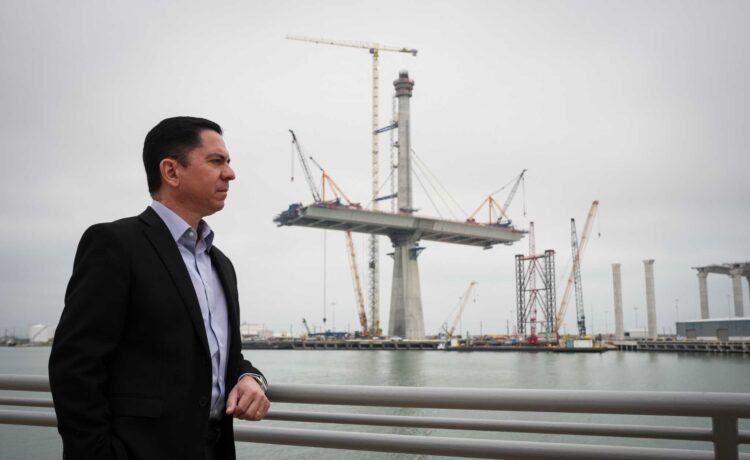Corpus Christi, a city of 320,000 three-hour’s drive south of the nation’s traditional energy capital, has quietly become the U.S. leader of oil exports, leading regional officials to dream big but frustrating some who live in the shadow of the city’s driving force, its expanding port.
More than half of the 4 million barrels of crude exported daily from the U.S. passed through the Port of Corpus Christi during the first half of 2023, according to the Energy Information Administration. This comes after the port exported an average of 2 million barrels of crude a day in 2022, a record high, along with significant volumes of liquefied natural gas and other petroleum products.
Advertisement
Article continues below this ad
“Currently, the Port of Corpus Christi crude oil export gateway ranks number one in the United States and number three in the world,” said CEO Kent Britton. “For the first time in history, Port of Corpus Christi customers moved more than 52 million tons of cargo in the third quarter of 2023.”
The port has an estimated economic impact on the Corpus Christi area of $13.4 billion, according to the South Texas Economic Development Center at the local branch of Texas A&M University. As 2023 draws to a close, the port and its customers are planning for continued growth. A dredging project underway will deepen the port’s ship channel to 54 feet; Cheniere Energy last year broke ground on an $8 billion expansion of its LNG facility.
Along with the port, in operation since 1926, the military has been and remains an important part of Corpus Christi’s economy, with Naval Air Station Corpus Christi, about 10 miles southeast of downtown, supporting pilot training since it was commissioned in 1941.
But Corpus Christi, the seat of Nueces County, is historically not an affluent city. Jim Lee, professor of economics at Texas A&M University-Corpus Christi and director of its South Texas Economic Development Center, encountered a slightly depressed situation when he took up his post in 2000.
Advertisement
Article continues below this ad
“At that time, people were still talking about the oil bust (of 1986),” he recalled recently during an interview at the Corpus Christi Regional Economic Development Corporation’s headquarters overlooking Corpus Christi Bay.
“I think our median income, when I moved here in 2005, was $37,000 a year,” agreed Sarah Tindall, the corporation’s senior vice president of external affairs. “We’re still below the Texas average, but it’s increased substantially the last few years.” As of 2022, according to the Census Bureau, median household income in Corpus Christi has grown to about $64,000 a year, compared with a state median of about $75,000.
The city’s location meant that its port was bound to be affected when the United States lifted a decadeslong ban on most crude oil exports in 2015. But Tindall identifies an inflection point several years earlier, when the development of the Eagle Ford shale area spurred a series of new pipeline projects. The Eagle Ford spans a region from the Rio Grande near Laredo northeast to College Station.
“The real story is that the pipelines came here. We were the closest port to the Eagle Ford shale,” she said. “Houston is a container port as well, so they didn’t have the room for exponential growth like we did, but originally they were getting the bulk of it, because the pipelines were already built.”
Advertisement
Article continues below this ad
Economic diversification has been a focus of regional economic development corporation’s efforts, Tindall said. In recent years the area has seen the opening of a new steel mill, which created about 600 jobs, and in May Tesla broke ground on its in-house lithium refinery in nearby Robstown. She and Lee pointed to several factors supporting economic development efforts in the region, including a diverse workforce, relative affordability, and higher education institutions such as TAMU-CC and Del Mar College that are keen to partner with industry.
Downtown’s efforts
Alyssa Barrera Mason, executive director of Corpus Christi’s Downtown Management District, reckons that revitalizing the city’s downtown will be key to attracting young workers to the city and encouraging those who grew up there, as she did, to stay rather than being lured away by cities such as Houston.
“Our mission statement is to create the most vibrant downtown on the Gulf of Mexico,” Mason said. “We are looking at being a colorful, culturally rich community — a place where creatives and entrepreneurs know that their talents are valued. It’s important that we improve the quality of life in Corpus Christi, so that we can compete for talent.”
While Corpus Christi hasn’t seen the explosive economic growth that some Texas cities have experienced over the past decade, Tindall added, in some ways that’s a good thing.
Advertisement
Article continues below this ad
“We’ve had moderate growth that’s been manageable,” she said.
‘Social injustice of petroleum’
But the growth of industry at the Port of Corpus Christi has put particular strain on neighborhoods in the city’s Inner Harbor such as Hillcrest, a historically African-American enclave. Homeowners LaMarcus and Jestine Knox, who both grew up in Hillcrest, recalled that it was once home to about 400 families, a number that has been whittled to about 100 today.
“This is the social injustice of petroleum — where you just go in and decimate a neighborhood for your own good,” LaMarcus said, pointing at several empty lots along his street.
Advertisement
Article continues below this ad
In recent years, they along with many neighbors have been campaigning against a seawater desalination plant the city has proposed in the neighborhood, which they say has the potential to displace even more families via buyouts. The Knoxes explained that they’re deeply rooted in Hillcrest, figuratively and literally. They still live in the home in which they raised their children. And they pointed to a stately oak tree in the front yard, which began as a seedling in a pot given to Jestine by a local car dealer in exchange for taking a test drive.
“I like living in the metro area,” said LaMarcus, 58. “I do not like planned subdivisions. I do not like living 30 minutes outside of town. I can sit in my backyard and see downtown.”
Challenges ahead
The port has faced some rough waters over the past year, however. In May, CEO Sean Strawbridge resigned shortly after a KRIS-TV investigation into executive expenses found “a pattern of lavish spending,” according to the television station. He was replaced by Britton, formerly the port’s CEO, in September.
In October, the Port of Corpus Christi suffered a disappointment when the Department of Energy passed over its proposal to host one of the nation’s federally funded hydrogen hubs, instead awarding the project to a group from Houston. The application process itself, Britton said, “brought clarity of mission and strategy” for the port.
Still, port officials are bullish on the future of the Port of Corpus Christi, and economic development officials see the potential for further diversification of the economy and growth within the city.
“Navy base, export terminal, downtown on the water,” said Tindall, adding with a laugh: “We’re basically just San Diego with humidity.”




